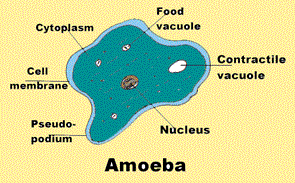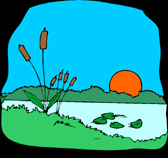PROTISTS
This
group is made up of
Protozoa
and Filamentous algae.
The
simplest protist is
the
amoeba.
WHAT
IS AN AMOEBA?

The amoeba
is a simple animal made up of just one cell.
It normally
lives in ponds, ditches or slowly moving streams.
The amoeba
is just visible to the naked eye.
It eats,
respires, digests food and excretes waste.
It moves
about, responds to stimuli, grows, is able to repair and reproduces.

HOW
DOES AN AMOEBA FEED?
The habitat
of the amoeba is the mud and water of ponds and ditches. In the
mud, there are many microscopic plants known as desmids.
When the protoplasm of the amoeba comes into contact with one
of these plants, it flows round the plant, forming a cup shaped
projection. This is literally a food cup, which completely encloses
and ingests the food. In this way a food-vacuole is formed in
the endoplasm. An amoeba, however, does not feed entirely on plants
it is also carnivorous feeding on tiny ciliates.
In the food vacuole, digestion commences and affected by similar
processes to higher animals. Enzymes are secreted into the food
vacuoles along with other digestive juices. The digested material
is now in a solution that can be absorbed into the surrounding
cytoplasm. Once all the digestible material has been absorbed
the remainder is excreted by the animal.
HOW
DOES AN AMOEBA RESPIRE?
Amoeba are
simple animals and their whole surface is in contact with the
water that surrounds them and which contains oxygen.
All the
oxygen the amoeba needs passes through the outer surface inwards
and carbon-dioxide which is a waste product, seeps outwards.
This takes
place by simple diffusion. As the amoeba uses up oxygen on the
inside, the concentrate of oxygen lowers, so there is less on
the inside than in the water outside.
The oxygen
then passes from the outer to the deeper parts of the protoplasm.
All living things need nutrition to provide energy and the protist
kingdom is no exception.
If we look at the amoeba, it gives us an example of a simple free
living protist.



